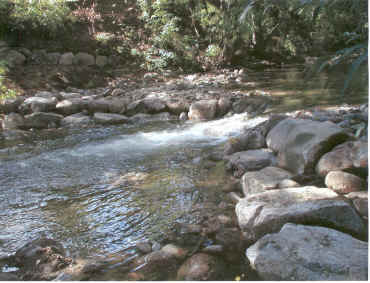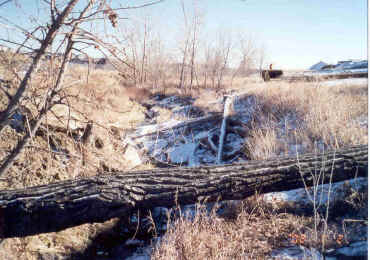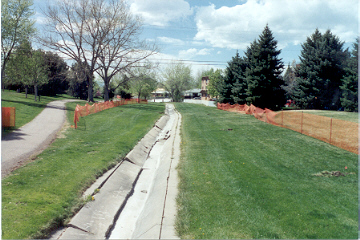|
|
Maintenance Program Activities
| ||||||||||||||
|
|
Harvard
Gulch looking upstream from Madison Street. |
New drop structure with concrete cutoff wall. |
A drop structure of concrete rubble and grout had been in place for years on Harvard Gulch just upstream of Madison Street in Denver. This facility had no cutoff wall and had been undermined by the stream. Our approach was to trench and pour a concrete wall for the cutoff and to use grouted boulders for the sloping face of the structure.
It is common to have utility lines cross streams. Many of them end up with concrete encasements to protect the utility from the stream. On Massey Draw, North Tributary in Jefferson County the stream eroded both under and around one end of a sewer line encasement. With the financial assistance of the sewer district we poured a concrete cutoff wall and placed grouted boulders for the drop structure face.
We also repaired several facilities that suffered from the second type of drop structure damage. A Capital Program project from the 1970s on Sanderson Gulch in west Denver included drop structures made of gabion baskets. The high bed load of sediment and vandalism combined to limit the service life of the gabions. The gabion drop on the east side of Federal Boulevard had been repaired in the past with sprayed-on concrete, but that was now deteriorating. We replaced that structure with a trenched and poured concrete cutoff wall with grouted boulders for the sloping face. We will continue replacing the old drop structures on Sanderson Gulch as funds are available.
 |
| Boulder Creek in the City of Boulder - restored drop structure. |
Just south of C-470 in Douglas County Willow Creek flows through an undeveloped area. Similarly, in Brighton, Line A, also called North Urban Channel, discharges to the South Platte River after flowing through a rural area. The structures on both these creeks shared a similar history in that they suffered from increased flows due to upstream development and the downstream channel was degrading resulting in undermining of the facilities. For both these structures we drove sheet pile to establish the cutoff wall and installed grouted boulders to create the face of the drop. We realize that since there is no grade control downstream of these structures they will still be vulnerable to vertical erosion in the downstream channel.
Stream-rounded boulders were used over the years by the City of Boulder to establish a dozen drop structures on Boulder Creek. These drops are two to three feet tall and have no concrete and no cutoff wall. The original boulders were locked into an arch shape through careful placement, but, eventually, in the cobble-bedded stream some of the rounded boulders became displaced. We imported some angular boulders and re-established an arched grade wall bedded in the cobbles. The rounded boulders were then placed downstream of the grade wall to give a sloping face to the structure.
Twenty-four projects were at various stages of design or construction during 2001. Those projects are listed in the accompanying table titled STATUS OF MAINTENANCE REHABILITATION PROJECTS. Rehabilitation projects usually take the form of consultant-designed repairs that are intended to address severe problems that have occurred on a previously improved urban drainageway. By the end of 2001 the District will have spent about $2,559,300 on rehabilitative design and construction for the year. A few of the unique projects are discussed below.
 |
| Niver Creek Tributary M - looking downstream from Huron Street. Severe channel degradation has been offset with urban debris. Construction begins January 2002. |
We are always doing something on Cherry Creek. In southeast Denver where the Highline Canal crosses the creek there is a massive 12 foot tall drop structure composed of dumped concrete rubble. As the creek bed downstream has degraded the structure has evolved into a drop that protects the Highline Canal siphon that crosses under Cherry Creek. Erosion has now exposed the siphon and the rubble appears inadequate to resist a major flood event. Several regional and local governments are participating with us in rebuilding this substantial structure including trail and park improvements for the large open space area.
Niver detention pond is a large regional facility located west of I-25 at 88th Avenue. Tributary M to Niver Creek joins Niver Creek just upstream of the dam. The dam provides some grade control, but by the time Tributary M reaches Huron Street the erosion is severe with 12 to 15 foot tall vertical banks and a headcut undermining the Huron Street culvert. Our project will include five drop structures and extensive bank reshaping.
One of this year's projects includes the elimination of an 18-inch diameter trickle flow/underdrain pipe. The East Toll Gate Tributary in Aurora has several grouted rock drop structures with deep stilling basins that drain into the 18-inch trickle flow pipe. The pipe is damaged or plugged in several areas. The drops are deteriorated and have become a safety problem because of the deep stilling basins. Rebuilding the drop structures and regrading the channel will allow all runoff to flow on the surface through the improved corridor. Aurora plans to upgrade the site to an irrigated bluegrass park.
 |
 |
DeBoer Park low flow channel before and after. |
|
The City of Denver also had a channel with a troublesome underdrain pipe. Harvard Gulch flows through DeBoer Park in south Denver. The underdrain was connected to multiple surface inlets with the intent of keeping the area dry during low flow periods. The thin slope-paved concrete of the trickle channel through the park had become displaced and broken-up to the extent that the trickle flows went under or around the inlets and never made it to the underdrain pipe. With the coordination of Denver Parks the five-foot wide concrete trickle channel was replaced with a boulder-edged low flow channel that varies from 10 to 15 feet wide.
|
Lilley Gulch looking downstream toward Wadsworth Blvd.
|
With the acquisition, by Foothills Park District, of a parcel of land west of Wadsworth Boulevard a final link was made in the Lilley Gulch corridor in Jefferson County. The additional public land allowed us to incorporate a re-aligned trail, streambank protection, and several areas of wetlands. Four drop structures will also be built to control the grade through this new open space park.